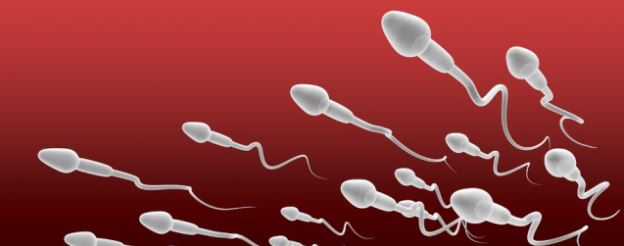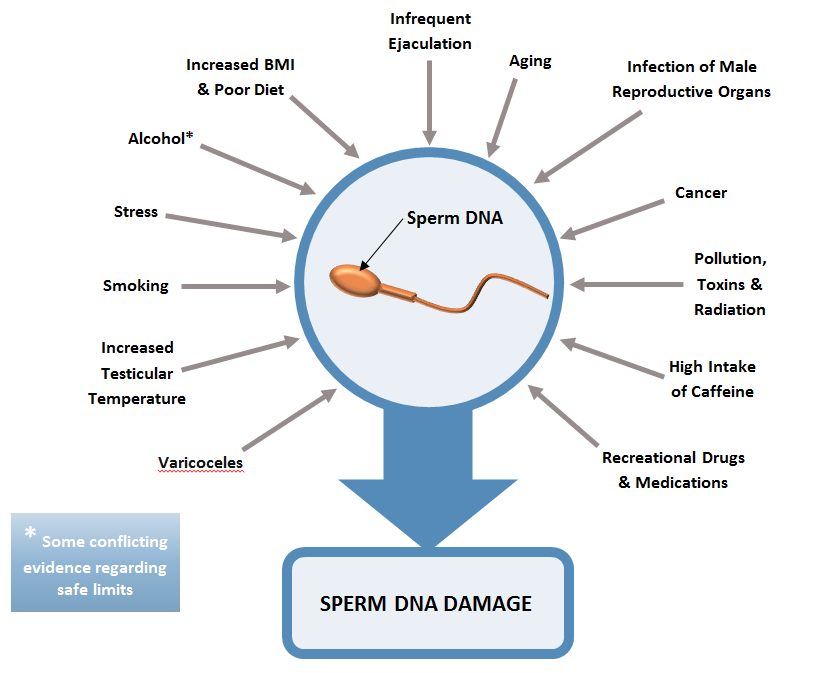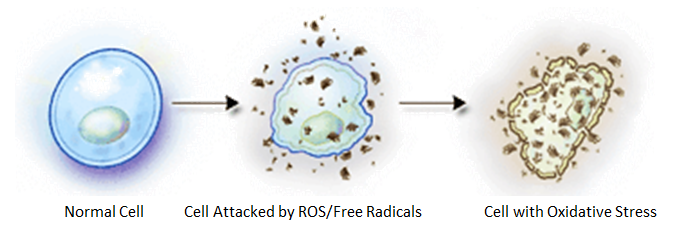Male factor infertility accounts for approximately 20% of infertility issues. However, when coupled with other female factors, it can contribute up to 50-60% of fertility problems. Due to this, your fertility specialist or GP may order a conventional semen analysis for all male patients. A semen analysis evaluates seminal volume, pH, sperm concentration, motility, morphology and antibodies. Although this test is thorough, it is purely looking at the external features of the sperm. It does not necessarily take into account any problems inside the sperm, such as the integrity of the DNA. Although DNA damage or fragmentation can be linked with poor semen parameters, approximately 8% of patients with DNA fragmentation can return a normal conventional semen analysis result. While this is not a large group of men, for some patients it could have a real and negative impact on their fertility potential.
Factors Leading To Sperm DNA Damage
Over the past decade, there has been a lot of research into male factor infertility. There is evidence to suggest that the sperm of infertile men contains more DNA damage than their fertile counterparts. This damage to sperm DNA can lead to serious consequences for fertility, such as; impaired fertilization, poorer embryo and blastocyst development, lower implantation rates and higher instances of miscarriage. Factors contributing to sperm DNA damage can be both internal and external (as per the diagram below):
Most of the factors listed above increase the level of Reactive Oxygen Species (ROS), also known as ‘Free Radicals’. They are located inside the cells in our body and cause ‘Oxidative Stress’ when our cells are no longer able to neutralize them.
ROS/Free Radicals cause damage to DNA, proteins and lipids – which are all essential in sperm production. The following factors increase the amount of ROS within the body and subsequently lead to sperm DNA damage:
- Age: Generally, we see a decline in sperm DNA integrity in male patients over the age of 40 years. This is due to age-related oxidative stress in their reproductive tracts. There are also higher instances of genetic mutation and chromosomal abnormalities in DNA as men age.
- BMI & Diet: Men should aim to maintain a healthy weight range and get regular exercise, as male obesity is associated with increased sperm DNA damage. In addition to this, men should consume a healthy, balanced diet in order to provide adequate nutrients for sperm production.
- Alcohol: Although some studies indicate that certain types of alcohol beverages (such as red wine) can have an antioxidant effect (which combats ROS/Free Radicals), there is also evidence that consumption of two or more drinks per day has a damaging effect on sperm DNA. As there currently some debate over this, it is best to limit alcohol intake.
- Ejaculation Frequency: There is a common misconception that if you ‘save it up’ and don’t ejaculate regularly, then you will have more sperm and have a better chance at fertilisation. This is definitely not the case. If you do this, you are in fact hindering your chance, as the sperm will have been exposed to the oxidative stresses of the body longer and as a result, have a higher amount of DNA damage. It is far better to ejaculate every 2-3 days to promote good sperm DNA integrity.
- Infections: Studies have shown that infections of the male genital tract resulting in inflammation, causes the over-production of leucocytes to combat the infection. An increase in amount of leucocytes has been associated to oxidative stress, which therefore has a negative effect on sperm DNA.
Other Factors Effecting Sperm DNA Quality
Other factors effecting sperm DNA quality include:
- Overheating: Testes are located on the outside of the body for a reason; this is because optimal sperm production occurs at slightly lower than normal body temperature. Higher testicular temperature is reported in men with clinical conditions (undescended testicles and varicoceles), certain occupations (baker’s, welders and professional drivers), those with poor posture and tight clothing. Men should also avoid hot spas/baths, sauna’s and even having your laptop on your lap.
- Caffeine: Studies have shown that consuming three or more cups of coffee per day (approximately 300mg caffeine) can damage sperm DNA. This is because caffeine is an effective inhibitor of the cell to repair DNA.
- Smoking: Everyone knows that smoking is bad for you and this is particularly true in regards to sperm quality. There is evidence that nicotine and other chemicals in cigarettes can increase the level of oxidative stress within the body and therefore cause damage to sperm DNA integrity.
- Recreational Drugs and Medications: Several illicit drugs have been linked with infertility, including marijuana, cocaine, methamphetamines, opioid narcotics and anabolic steroids. Short term use can lead to a reduction in sperm quality and libido. Chronic use increases the chance that permanent damage will result. In the case of cocaine, residual effects can be seen for up to two years from last use. Medications such as chemotherapy drugs, those used to treat high blood pressure, an overproduction of stomach acid, gout, urinary tract infections, inflammation, certain types of antibiotics, seizures, fluid retention and methadone all lead to a decrease in sperm quality.
- Pollution, Toxins and Radiation: Environmental exposure to pollutants such as dioxin, as well as pesticides and herbicides has been shown to cause sperm DNA damage. Occupational exposures to metals, paints, solvents, degreasers, non-water-based glues can also have a detrimental effect on DNA quality.
Tests To Determine Sperm DNA Fragmentation
There are a couple of tests which are useful to determine the degree of sperm DNA fragmentation. Tests that are considered the ‘gold standard’ when assessing sperm DNA damage are the Sperm Chromatin Structure Assay (SCSA) and Sperm Chromatin Integrity Test (SCIT). They examine up to 5,000 sperm cells and are extremely sensitive. During the test, sperm cells are stained with a fluorescent DNA dye (acridine orange) and passed through the point of a laser beam. The laser light causes the dye to emit fluorescent light at different colours, depending upon the amount of DNA damage.
For the SCSA test, sperm which have no DNA damage are coloured green. If sperm appear yellow, they have moderate DNA damage, while red coloured sperm have a high level of damage. The sperm are counted using specialized software to determine the percentage of sperm that are yellow to red colour. This result is known as a DNA Fragmentation Index (DFI%) and is the percentage of DNA damage that a sperm has.
Another test is the Halosperm kit, which is a commercial kit available to determine the levels of sperm DNA fragmentation. With this test, the sperm are captured within an inert agarose gel. This is treated, with an acid denaturant that removes already fragmented DNA. The remaining material is then treated with a lysing agent, which frees the intact DNA into the agarose gel. This agarose is then stained to highlight the released DNA and evaluated to determine the degree of fragmented vs. intact DNA.
Sometimes the woman’s eggs are able to repair sperm DNA damage to a certain extent. However, when DNA damage is extensive, or the egg is not of good quality, the egg does not have the capacity to overcome this and as a result, normal embryo development does not occur. Depending on what caused the sperm DNA damage, there may be ways to improve the integrity of the DNA. This includes eliminating, or at least reducing the number of factors that are contributing to your sperm DNA damage. However, as new sperm are only produced every 3 months, it may take some time to see the benefits of any changes made.
For more information on whether this applies to your situation, please contact your Fertility Solutions Specialist or one of our scientists.
References:
Cdc.gov,. (2014). CDC – Preconception Care, Health Professionals, Men, Exposures. Retrieved 18 August 2014, from https://www.cdc.gov/preconception/careformen/exposures.html
Charlotte Dupont, R. (2013). Obesity leads to higher risk of sperm DNA damage in infertile patients. Asian Journal Of Andrology, 15(5), 622. doi:10.1038/aja.2013.65
Esteves, S. (2014). Sperm DNA Fragmentation in Male Infertility. Slideshare.net. Retrieved 18 August 2014, from https://www.slideshare.net/sandroesteves/sperm-dna-fragmentation-in-male-infertility
Kopa, Z., Wenzel, J., Papp, G., & Haidl, G. (2005). Role of granulocyte elastase and interleukin-6 in the diagnosis of male genital tract inflammation. Andrologia, 37(5), 188-194. doi:10.1111/j.1439-0272.2005.00676.x
Paul, C., Murray, A., Spears, N., & Saunders, P. (2008). A single, mild, transient scrotal heat stress causes DNA damage, subfertility and impairs formation of blastocysts in mice. Reproduction, 136(1), 73-84. doi:10.1530/REP-08-0036
Schmid, T., Eskenazi, B., Baumgartner, A., Marchetti, F., Young, S., & Weldon, R. et al. (2007). The effects of male age on sperm DNA damage in healthy non-smokers. Human Reproduction, 22(1), 180-187. doi:10.1093/humrep/del338
Schulte, R., Ohl, D., Sigman, M., & Smith, G. (2009). Sperm DNA damage in male infertility: etiologies, assays, and outcomes. J Assist Reprod Genet, 27(1), 3-12. doi:10.1007/s10815-009-9359-x



